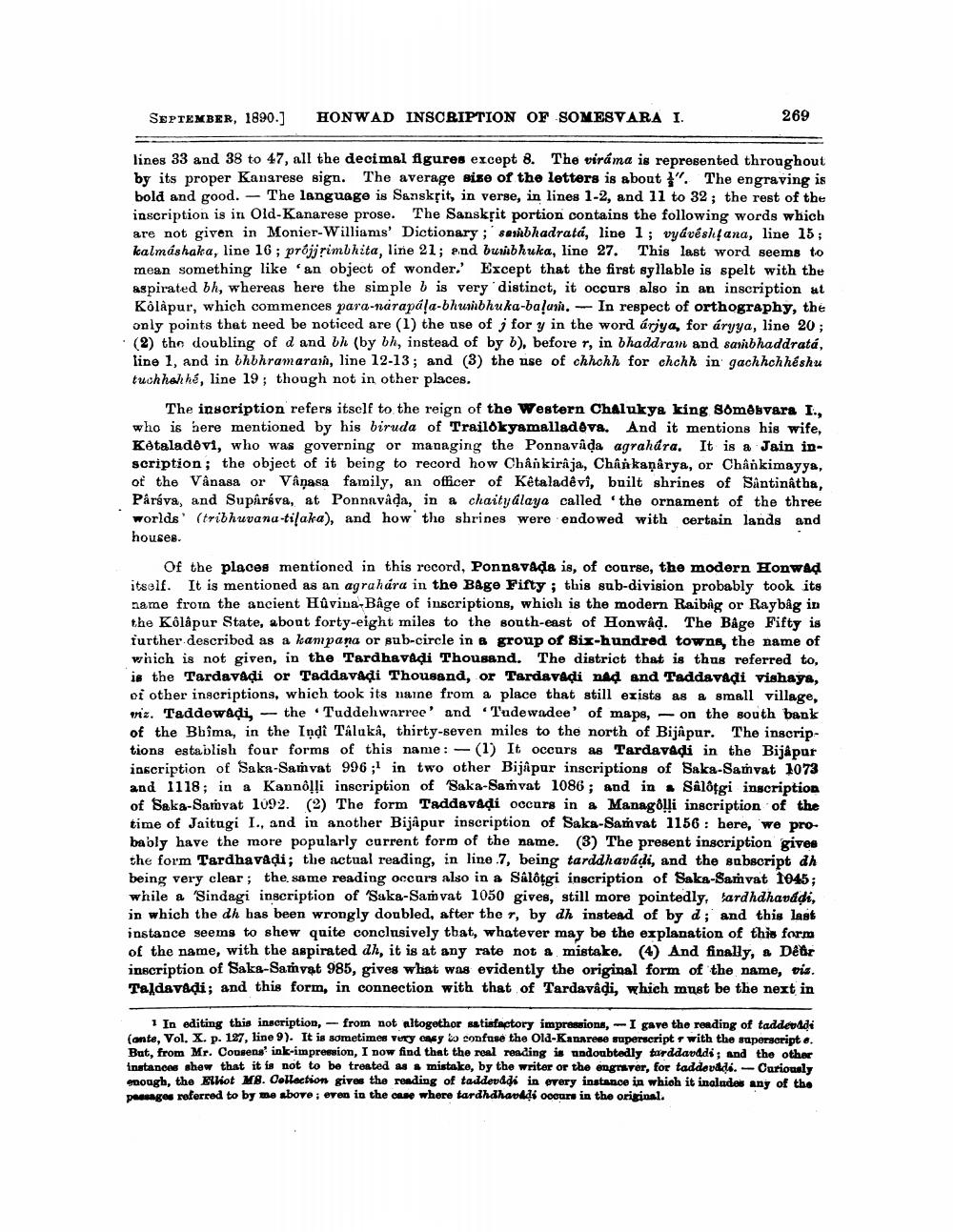________________
SEPTEMBER, 1890.)
HONWAD INSCRIPTION OF SOMESVARA I.
269
lines 33 and 38 to 47, all the decimal figures except 8. The viráma is represented throughout by its proper Kanarese sign. The average size of the letters is about ". The engraving is bold and good. - The language is Sanskřit, in verse, in lines 1-2, and il to 32; the rest of the inscription is in Old-Kanarese prose. The Sanskrit portion contains the following words which are not given in Monier-Williams' Dictionary ; sasabhadratá, line 1; vydveshufana, line 15; kalmáshaka, line 16 ; projj rimbhita, line 21; and buribhuka, line 27. This last word seems to mean something like an object of wonder. Except that the first syllable is spelt with the aspirated bh, whereas here the simple b is very distinct, it occurs also in an inscription at Kolapur, which commences para-narapála-bhumbhuka-baluri. - In respect of orthography, the only points that need be noticed are (1) the use of j for y in the word áriya, for áryya, line 20; (2) the doubling of d and bh (by bh, instead of by b), before r, in bhaddram and savbhaddratá, line 1, and in bhbhramarar, line 12-13; and (3) the use of chhchh for chchh in gachhchhéshu tuchhalhé, line 19; though not in other places.
The inscription refers itself to the reign of the Western Chalukya king Somebvara I., who is here mentioned by his biruda of Trailokyamalladeva. And it mentions his wife, Kataladovi, who was governing or managing the Ponnavada agrahdra. It is a Jain inscription; the object of it being to record how Chånkirâja, Chankaņarya, or Chânkimayya, of the Vanasa or Vanasa family, an officer of Kêtaladêvî, built shrines of Santinátha, Páráva, and Suparáva, at Ponnavada, in a chaityalaya called the ornament of the three worlds' (tribhuvanu-tisaka), and how the shrines were endowed with certain lands and houses.
Of the places mentioned in this record, Ponnavada is, of course, the modern Honwad itself. It is mentioned as an agrahára in the Bage Fifty; this sub-division probably took its name froin the ancient Hûvina-Bâge of inscriptions, which is the modern Raibag or Raybag in the Kôlâpur State, about forty-eight miles to the south-east of Honwad. The Bâge Fifty is further described as a kampana or sub-circle in a group of six-hundred towns, the name of which is not given, in the Tardhavadi Thousand. The district that is thus referred to, is the Tardavadi or Taddavadi Thousand, or Tardavadi nad and Taddavadi vishaya, of other inscriptions, which took its naine from a place that still exists as a small village, miz. Taddewadi, -- the .Tuddeh warree' and 'Tudewadee' of mape, - on the south bank of the Bhima, in the Indi Taluka, thirty-seven miles to the north of Bijapur. The inscriptions establish four forms of this name : - (1) It occurs as Tardavadi in the Bijapur inscription of Saka-Samvat 996 ;' in two other Bijapur inscriptions of Saka-Samvat 1073 and 1118; in a Kannolli inscription of Saka-Samvat 1086; and in . Salotgi inscription of Saka-Samvat 1092. (2) The form Taddaveți occurs in a Managolli inscription of the time of Jaitugi I., and in another Bijapur inscription of Saka-Samvat 1156 : here, we probably have the more popularly current form of the name. (3) The present inscription gives the form Tardhavadi; the actual reading, in line 7, being tarddhavádi, and the subscript dh being very clear; the same reading occare also in a Sâlôtgi inscription of Saka-Samvat 1045; while a Sindagi inscription of Saka-Samvat 1050 gives, still more pointedly, ardhdhavddi, in which the dh has been wrongly doubled, after the r, by dh instead of by d; and this last instance seems to shew quite conclusively that, whatever may be the explanation of this form of the name, with the aspirated dh, it is at any rate not a mistake. (4) And finally, & Dêdir inscription of Saka-Samvat 985, gives what was evidently the original form of the name, bis. Taldavadi; and this form, in connection with that of Tardavadi, which must be the next in
In editing this inscription, - from not altogethor satisfactory impressione, I gave the reading of taddeldi (ante, Vol. X. p. 127, line 9). It is sometimes vury cwy lo confuse the Old-Kanarese superscript with the superscript o. But, from Mr. Cousens ink-impression, I now find that the real reading is undoubtedly tarddarddi; And the other inatanong show that it is not to be treated as a mistake, by the writer or the engraver, for taddoved. Curiously enough, the hot MB. Collection gives the reading of taddeuddi in every instance in which it includes any of the pessages referred to by me above; even in the case where tardhdhaoldi occur in the original.




